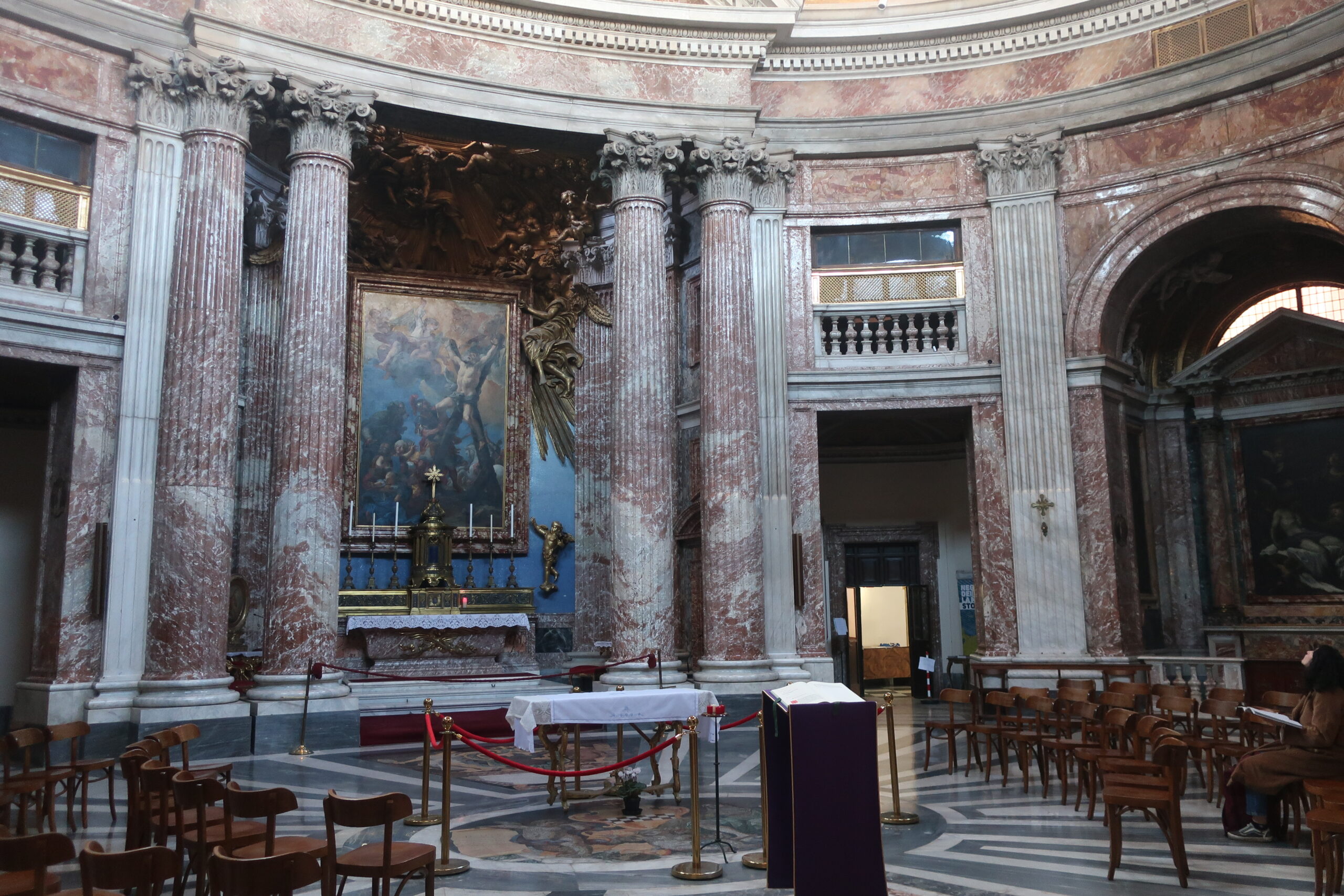Table of Contents
(33) Basilica Sant'Andrea al Quirinale - Bernini's Pantheon, an architectural masterpiece!
This time, I would like to introduce the Basilica Sant'Andrea al Quirinale, which has been called the masterpiece of Bernini's church architecture in his later years.
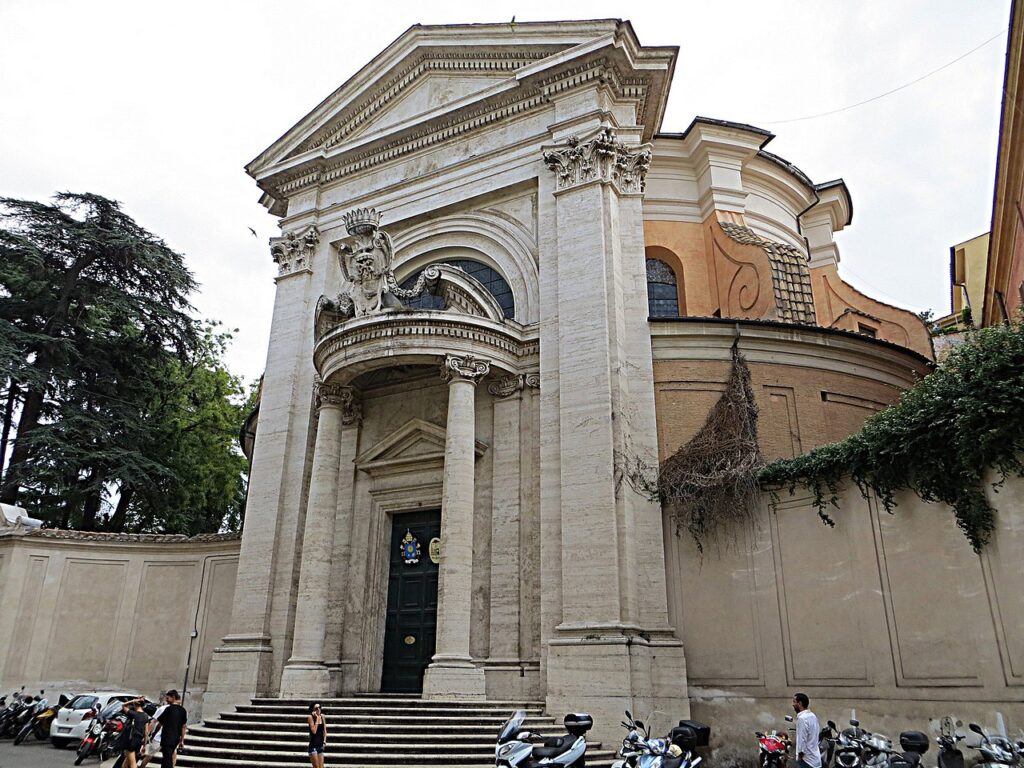
Bernini overcame adverse conditions to create a masterpiece.
San Tandrea, under the patronage of Camillo Pamphili, nephew of former Pope Innocentius X, the Jesuit(Catholic) neophyteThe church was built for Pope Alexander VII and Pope Bernini. The passion with which Alexander VII and Bernini worked on the construction of this church is evident in the Pope's own diary, which shows that the three discussed their plans many times.
However, the construction of this church posed a problem right from the start. Because a monastery had already been built on the site, the only available site for the church was a long, horizontal lot with no depth. To overcome this disadvantage, Bernini adopted a drastic solution: a horizontal elliptical plan. The horizontal elliptical plan is not entirely unprecedented (Fornovo built a church in Parma in 1566). Nevertheless, it is still a bold and original attempt.
What is even more praiseworthy is that Bernini made the most of the unfavorable conditions given to him to create a work that is considered one of the masterpieces of Baroque architecture. Bernini always believed that the most praiseworthy thing in architecture is not merely to create a beautiful and splendid building, but to overcome the adverse conditions given to him and transform them into a beautiful work of art.
In the case of sculpture as well, we have already noted that he preferred to tackle difficult challenges and made great efforts to overcome them. The disposition to use difficulties as a springboard for creation was no different in the case of architecture. He even said, "If it [the obstacle] did not exist, it would be necessary to create it. The horizontal elliptical plan of San Tandrea is a good example of how adverse conditions stimulated Bernini's creativity.
Masumi Ishinabe, Yoshikawa KobunkanBernini, Giant Star of Baroque Art.p144-145
*some line breaks.

As noted in the commentary above, Bernini designed this cathedral in the unfavorable conditions of a horizontal lot. It would have been easier to design a vertical or square site. However, Bernini was different in this unfavorable situation, which normally would have clogged up the design. He was a man who was more energized by adversity.
A marvelous interior space that could be described as Bernini's Pantheon.
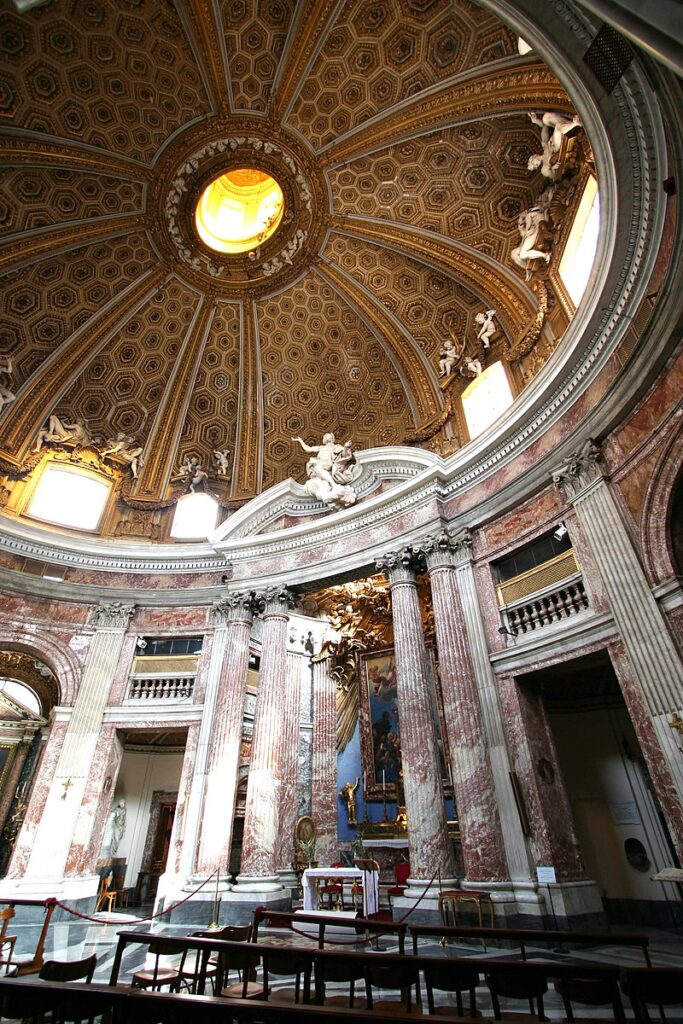
What kind of space awaits us inside? As we pushed the door open and stepped into the cathedral, we were confronted with an unexpected space, a horizontal ellipse. The altar in front of us seemed to be much closer, and the space was curved and spread out horizontally. It is a space that we have never seen before.
However, despite its narrowness and peculiar shape, this space is not suffocating, but rather gives the impression of spaciousness. The balance of details such as columns and cornices is exquisite, and the articulation of the space is smooth. In other words, the elliptical form creates both a quiet dynamism and a sense of spatial stability based on proper proportion. This fusion of seemingly contradictory elements, dynamism and stability, reminds us of the Pantheon, one of the great architectural masterpieces of antiquity. In fact, Bernini considered the Pantheon to be the best architecture, saying that while St. Peter's Basilica had 100 defects, the Pantheon did not. I secretly believe that the Basilica of San Tandrea is the crystallization of Bernini's devotion to the Pantheon and everything he learned there. (omitted).
By the way, this cathedral is sometimes called the "Pearl of Bernini. As it is, it is small but beautiful and, in the Italian way, "simpatico," in other words, it is a nice cathedral. I think this is also the reason why this cathedral is preferred as a wedding venue. And we cannot overlook the fact that the source of this charm lies in the beauty of the stone materials used. I have just mentioned that the spatial composition of this cathedral is fundamentally influenced by the Pantheon, and I believe that the use of stone materials is also influenced by what I learned at the Pantheon. For example, Bernini skillfully uses reddish-purple colored marble called "pavonazetto" after careful examination. Such interior decorations using colored marble are a Baroque "trait," but I have never seen such a successful example as in this cathedral. This is a clear indication of Bernini's keen sense of materials, as well as his ongoing exploration of the problem of color in sculpture and architecture.
Yoshikawa Kobunkan, Masumi Ishinabe, "As Long as San Pietro Stands, My Guide to Rome.P278-280
*some line breaks.
It is very interesting that this cathedral is a "simpatico" space. And it is even more surprising that this is a popular place for weddings. It is too enviable to have a wedding in such a wonderful cathedral.
Bernini's goal was to reach a point of total art.

As mentioned earlier, the interior space feels spacious, which is also due to the fact that the altar is recessed in the back. This altar is separated from the ellipse by four columns, which form an independent edicola (niche (in Western architecture)The four columns that serve as partitions are also of extraordinary ingenuity. The four columns that serve as partitions are also of extraordinary ingenuity, because they form the framework of the altar, which is illuminated by a light source other than the ellipse. The four columns form the framework of the altar, which is illuminated by a light source other than the ellipse, making the altar look like a painting, and preventing the flow of the ellipse from being blocked by the altar.
On this altar is the "Martyrdom of St. Andrea" by Guglielmo Cortese. Another cathedral dedicated to the same saint, the Basilica of San Tandrea della Valle, also has a martyrdom on its altar, so the choice of subject matter is quite orthodox. However, the dominant image in this cathedral is not the martyrdom, but the Ascension of St. Andrea on the front gable. The statue, which Bernini had his assistant Raggi create, rides a cloud and is about to ascend to heaven. The position and color of the statue naturally attract the attention of those who enter the cathedral. In other words, Bernini clearly made this statue the star of the drama. At the same time, he intended the entire cathedral to be a theater for the mystical drama of the Ascension of St. Andrea.
In fact, the dome is the heaven where St. Andreas ascended to heaven, and there is a full circle of dancing angels holding palm fronds, floral ropes, oars, nets, and shells to represent St. Andreas (Andre), a fisherman. A lantern with a dove, the symbol of the Holy Spirit, emits golden light, the light of heaven. It is also worth noting that the dome of heaven is made of white stucco and decorated with gold, while the lower pillars and cornices are made of dark stone.
Here, painting, sculpture, light, and color all merge beautifully within the space to express a single drama. The cathedral was thus unified in meaning and completed as a theater for religious drama, a concept that is entirely Bernini-like, and the Cathedral of San Tandrea al Quirinale, a perfect realization of this concept, is, in my opinion, the achievement of the comprehensive art that Bernini aimed for. I think.
Yoshikawa Kobunkan, Masumi Ishinabe, "As Long as San Pietro Stands, My Guide to Rome.P280-282
*some line breaks.
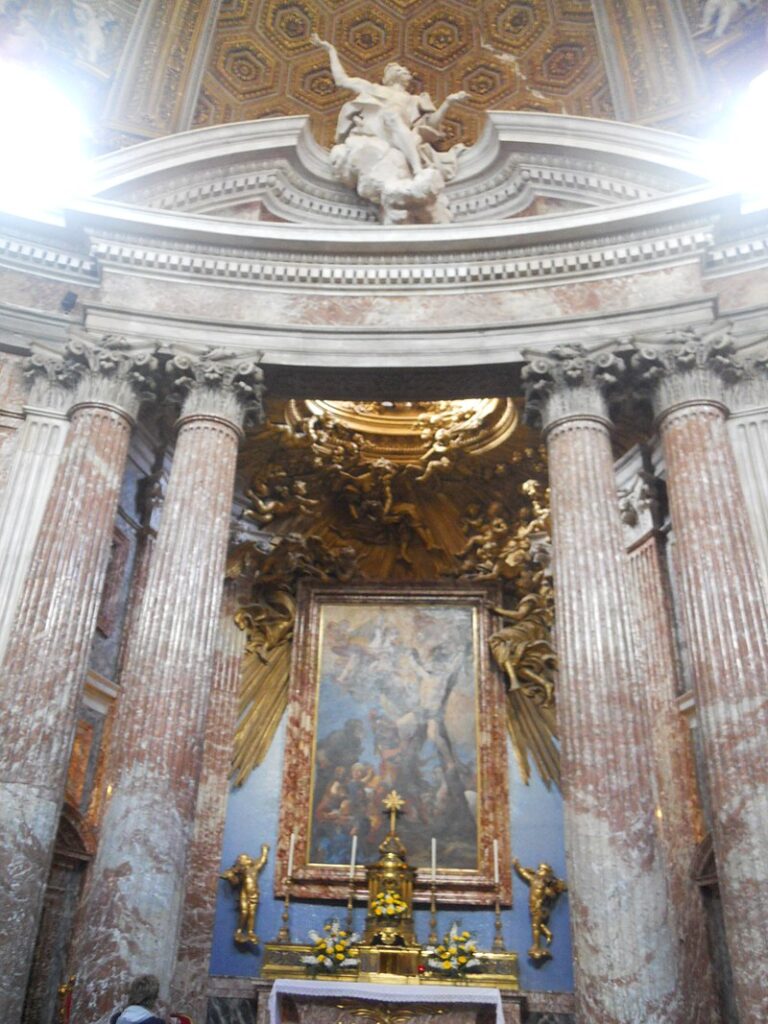
The Basilica of San Tandrea al Quirinale was the culmination of Bernini's vision of total art.
This is a very important point when considering this cathedral. I think it expresses in one word the value of this cathedral, the masterpiece of Bernini's last years.
And at the end of the commentary, I would like to share a heartwarming episode about this cathedral and Bernini.
Bernini's own most beloved work, Sant'Andrea al Quirinale
One day, when Domenico entered San Tandrea to pray, he met his father in the corner, happily looking around the interior. When Domenico asked him what he was doing alone, Bernini replied, "Son, this architectural work is the only thing that gives me special pleasure. So I come here from time to time to relieve myself from my work and console myself with my creations. Domenico felt that he had discovered a surprising side to his father, as he had expected him to be unsatisfied with his own work. The image of Bernini in his final years (the decoration of this church was completed in 1670) that emerges from the episode Domenico relates is moving. It is rather a reminder of his long and unyielding creative career. We cannot help but rejoice with Bernini himself that his ideals have been realized in their most perfect form in this small church.
Masumi Ishinabe, Yoshikawa KobunkanBernini, Giant Star of Baroque Art.p148
His son, Domenico, found his father, Bernini, happily looking around this cathedral. At that time, Bernini was already in his 70s, and in his old age. It is a touching episode that his father was comforted by his own works. In fact, it is an easy walk from his house to this cathedral. I walked there many times during my stay in Rome. It was very significant for me, a Bernini fan, to know that this cathedral was the place where Bernini himself was deeply satisfied with his work.
Visit the Basilica of Sant'Andrea al Quirinale
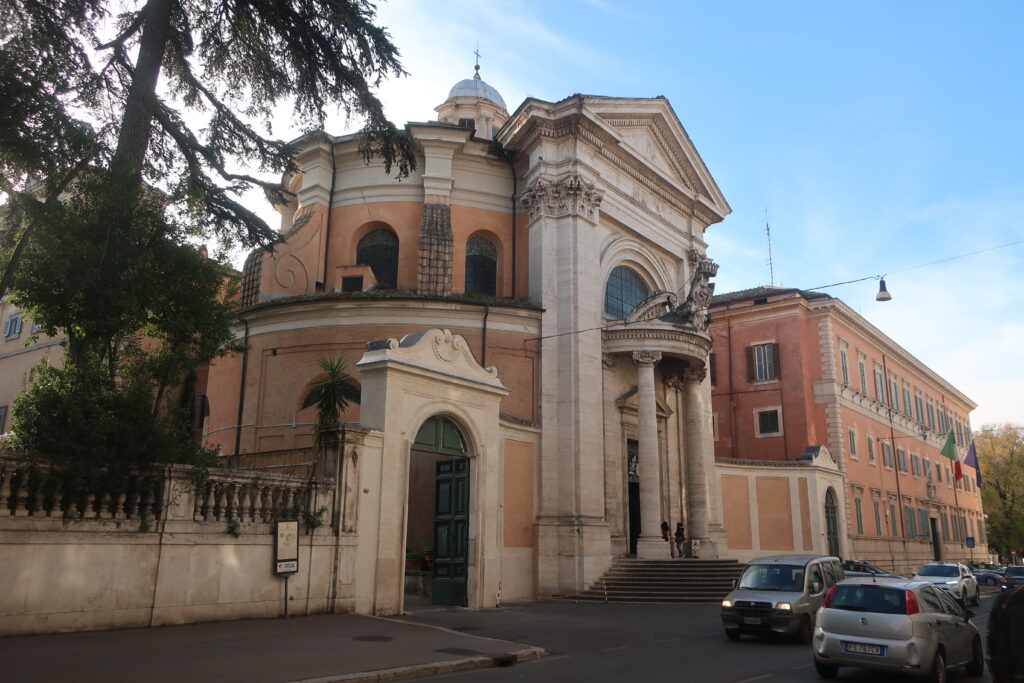
The Basilica of San Tandrea al Quirinale is within walking distance from Termini station. I was staying near Termini station, so I walked to this cathedral.
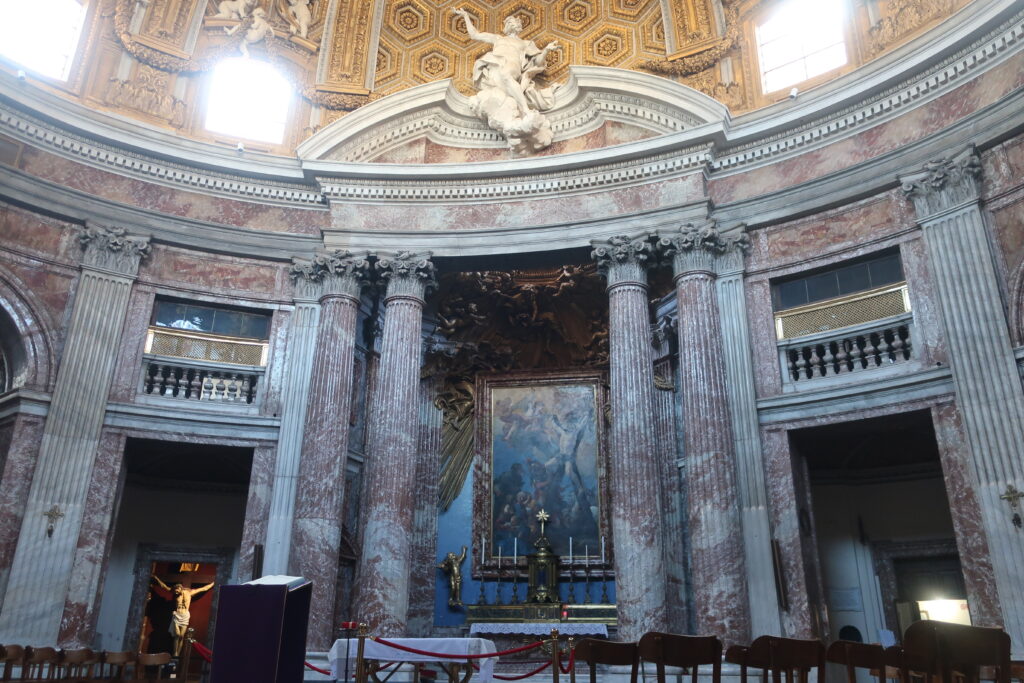
As Masumi Ishinabe stated, I too gasped the moment I entered this cathedral. What is this place? I was taken aback. I couldn't help but say, "It's the Pantheon....
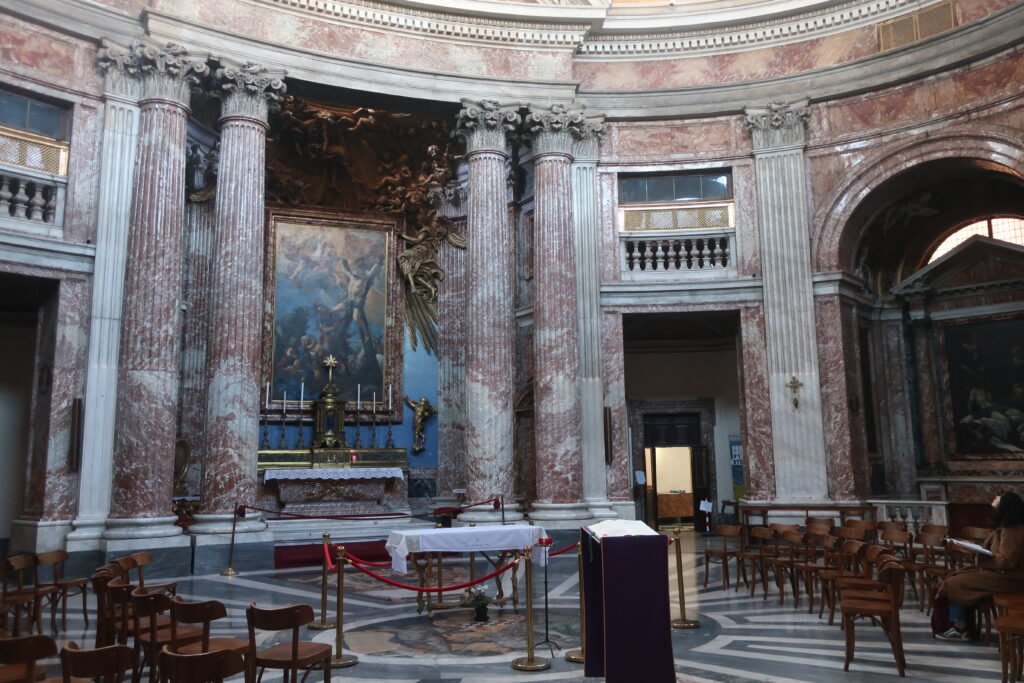
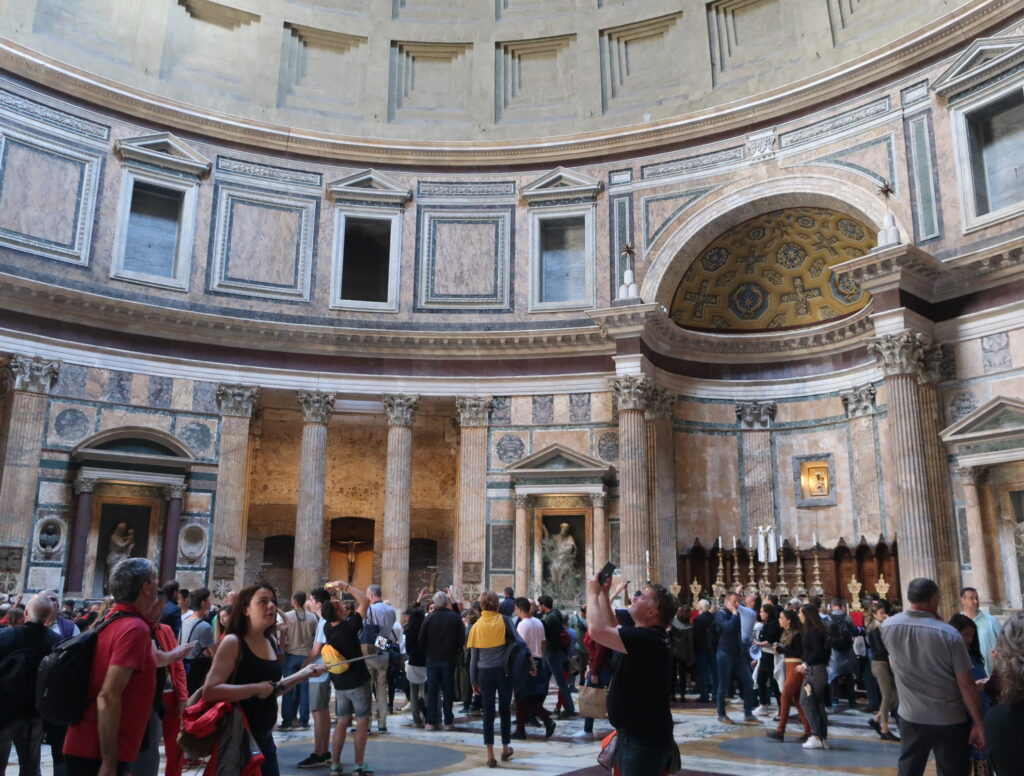
From its color to its shape, it looks just like the Pantheon. However, when you think about it carefully, you will be astonished. The Pantheon is a perfect circle, but this cathedral is an oval. And yet, there is a perfect harmony here that makes us forget that it is an oval.
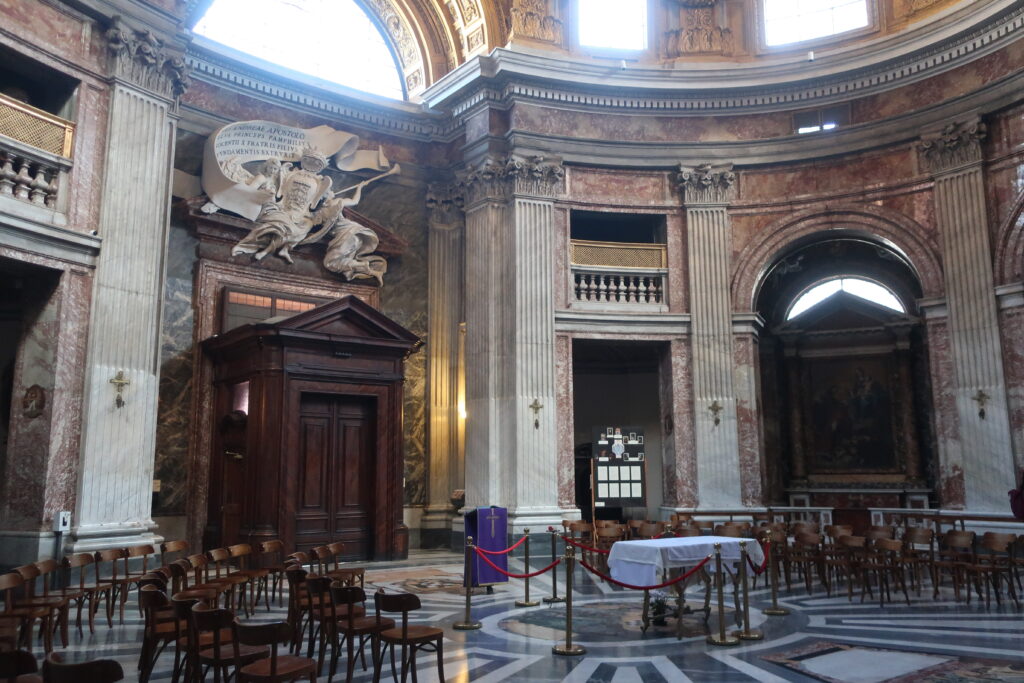
This is the entrance side.
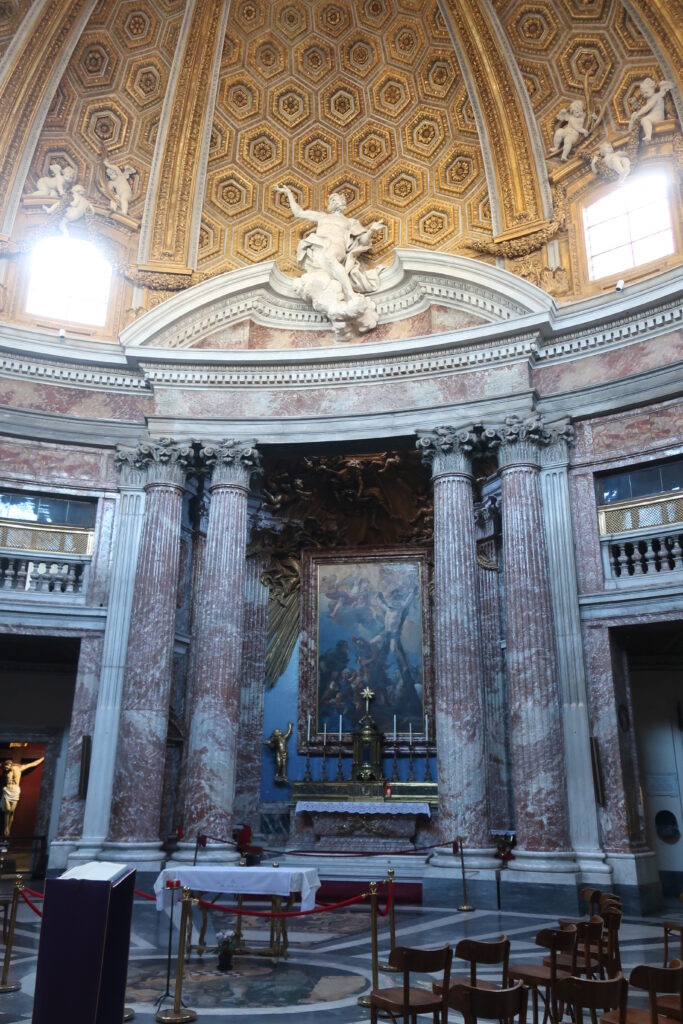
The central altar. It is just as if Andere were ascending to heaven.
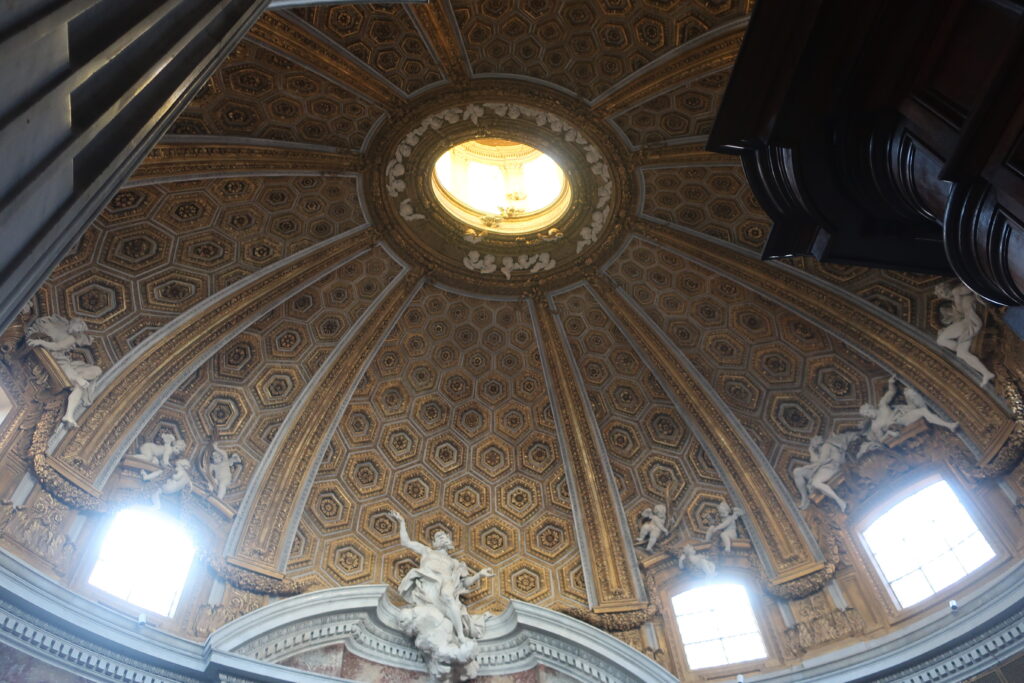
The golden decoration of the dome is also beautiful. The world of light shining through the lighting is embodied in the dome. The line extending toward the top of the dome is also pleasant.
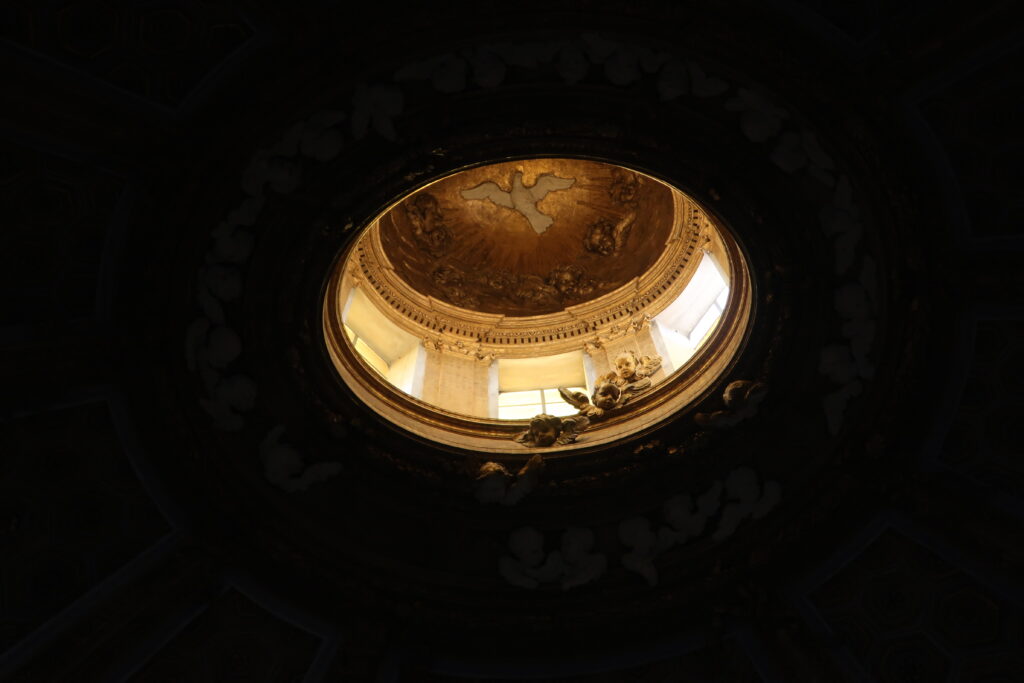
At the top of the dome is a dove representing the Lord. The lovely angels in the lighted windows show the mischievousness of Bernini.
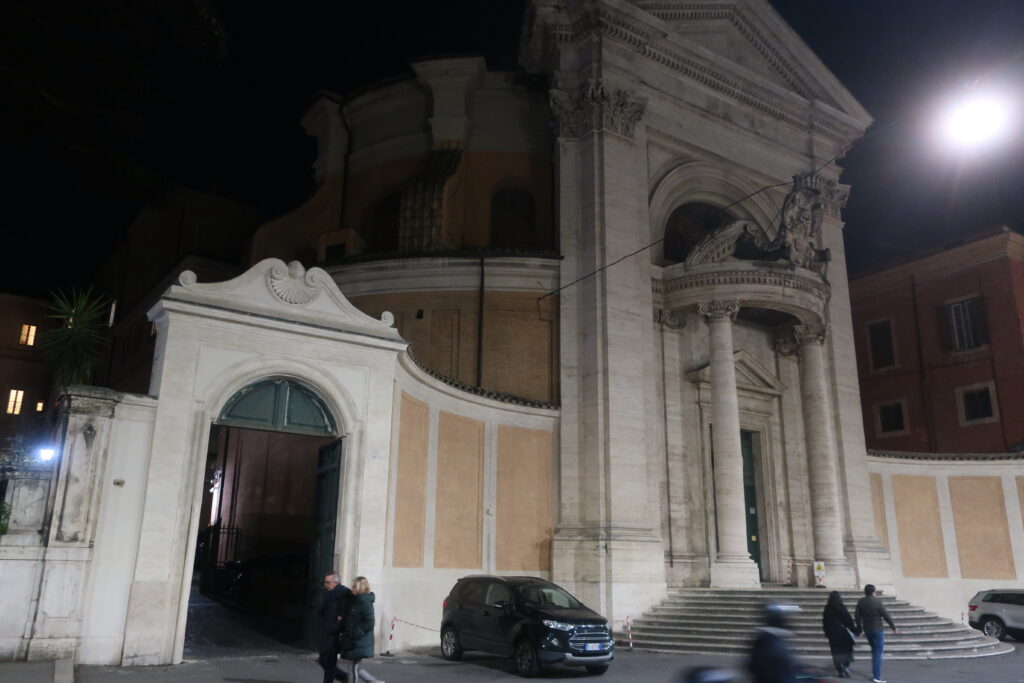
The sun sets early in Europe at the end of November.
I also visited this cathedral at sunset.
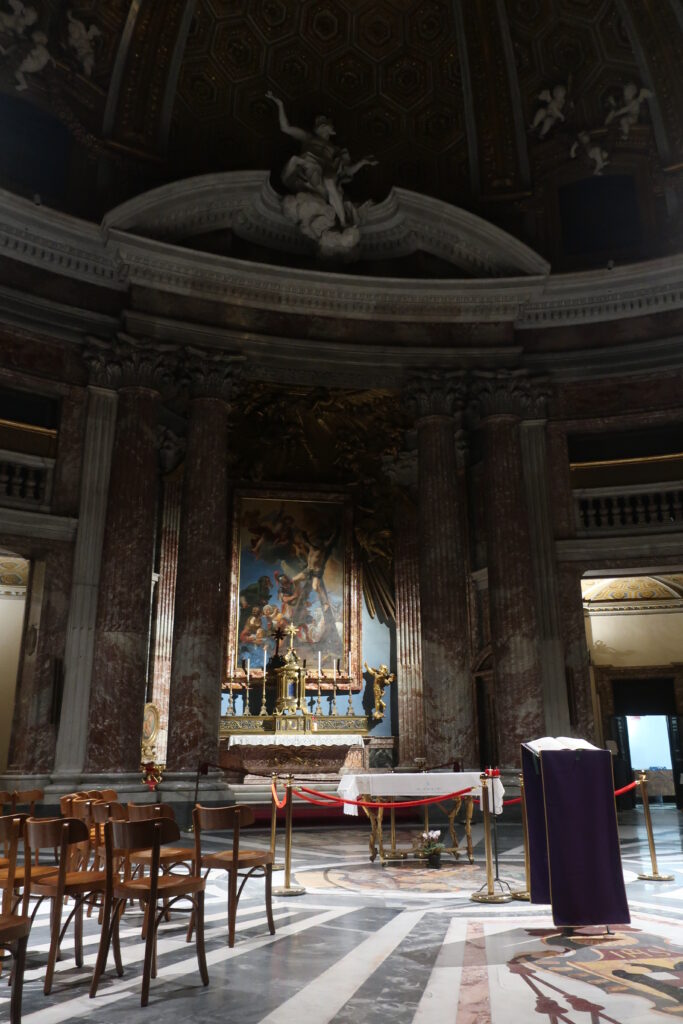
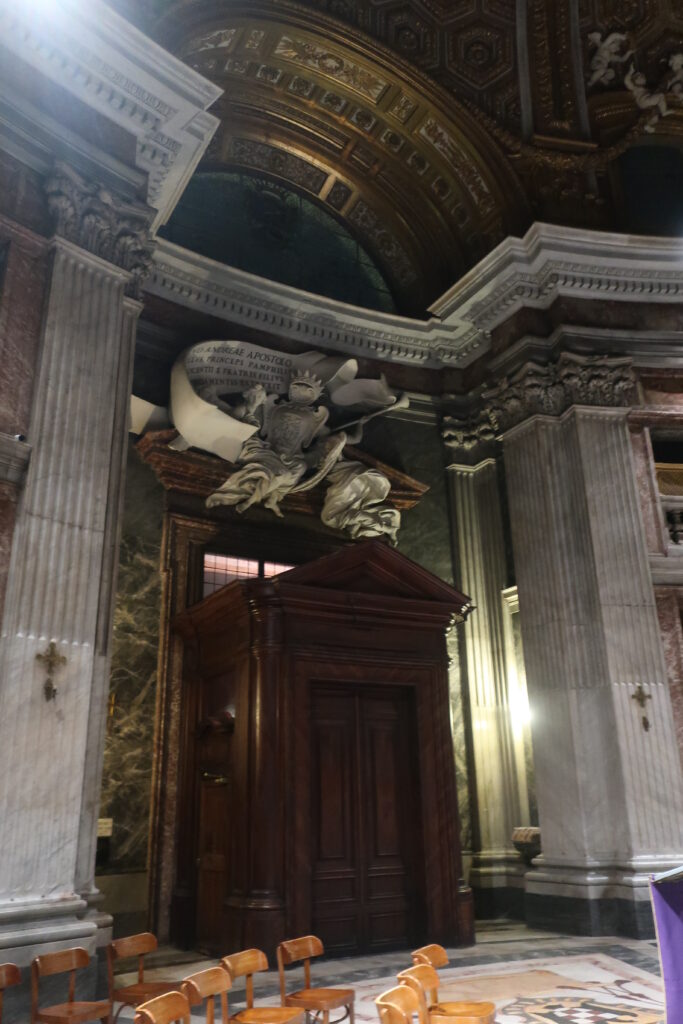

I've introduced you to them so far.Raimondi Chapeleven ifBasilica of Santa Maria Cecilia, ,Jez ChurchBut for some reason, the church was almost empty at dusk. You have this wonderful space almost all to yourself. In the silence, you can enjoy this church, which Bernini himself loved, to your heart's content.
Bernini also stood in this empty church and consoled himself. I spend time slowly, imagining such a scene.
Bernini designed this cathedral by overcoming the unfavorable conditions of having only a wide horizontal plot of land. I am moved by Bernini's spirit.
I was instantly captivated by this cathedral and visited it four times during my stay in Rome. Each time, I marveled at the beauty and perfect balance of this cathedral, Bernini's Pantheon.
This is a church that is not on the main route of sightseeing in Rome. There are many famous landmarks in Rome, such as the Pantheon, the Colosseum, and the Mouth of Truth. It is not surprising that you could finish your itinerary just by visiting those famous sights. However, the Basilica of Sant'Andrea al Quirinale is an amazing place. It may sound like a maniac, but I strongly recommend you to visit this place as well. The Pantheon is really here. It is an architectural marvel that was achieved under difficult conditions. If you are ever in Rome, I hope that you will experience Bernini's masterpiece. It is a wonderful cathedral that is sure to astonish you.
be unbroken
*The list of articles in the "Rome Travel Journal" can be found atCategory page hereindicates direction or goal (e.g. "to")
*Please visit this category page for recommended books to learn about Rome and Italy.
The Rise and Fall of the Roman Empire, the Vatican, and Roman Catholicism."
The Italian Renaissance and the Revolution in Knowledge."
*The following photos are my Bernini notes. I hope you will find them useful.

Next Article.
Click here to read the previous article.
Related Articles











